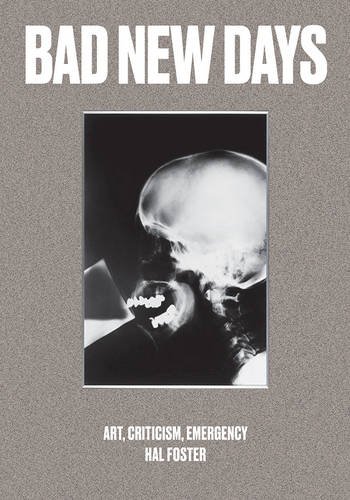Hal Foster: Bad New Days: Art, Criticism, Emergency (2015)
Filed under book | Tags: · abject, aesthetics, archive, art, art criticism, art history, critique, dialectic, fetish, mimesis, neoliberalism, poststructuralism, precarity, theory

“Bad New Days examines the evolution of art and criticism in Western Europe and North America over the last twenty-five years, exploring their dynamic relation to the general condition of emergency instilled by neoliberalism and the war on terror.
Considering the work of artists such as Thomas Hirschhorn, Tacita Dean, and Isa Genzken, and the writing of thinkers like Jacques Rancière, Bruno Latour, and Giorgio Agamben, Hal Foster shows the ways in which art has anticipated this condition, at times resisting the collapse of the social contract or gesturing toward its repair; at other times burlesquing it.
Against the claim that art making has become so heterogeneous as to defy historical analysis, Foster argues that the critic must still articulate a clear account of the contemporary in all its complexity. To that end, he offers several paradigms for the art of recent years, which he terms “abject,” “archival,” “mimetic,” and “precarious.””
Publisher Verso, London and New York, 2015
ISBN 1784781460, 9781784781460
208 pages
Presentation and discussion (video, The Kitchen, NYC, Sep 2015)
Interview (John Douglas Millar, Mute, Nov 2015)
Reviews: Mark Steven (Affirmations 2015), Brian Dillon (Guardian 2015), Rachel Wetzler (ArtNews 2015).
Comment (1)Mel Gordon: Voluptuous Panic: The Erotic World of Weimar Berlin (2000–)
Filed under book | Tags: · 1920s, berlin, body, cabaret, desire, drugs, eroticism, fetish, occultism, pornography, sex, sexuality, weimar republic

This sourcebook of rare visual documents and study of pre-Nazi, Cabaret-period “Babylon on the Spree” has the distinction of being praised both by scholars and avatars of contemporary culture.
Publisher Feral House, Los Angeles, 2000
Expanded edition, 2006
ISBN 1932595112
303 pages
Review: Lemons (Salon, 2000).
PDF, PDF (64 MB, updated on 2018-5-8)
See also Karl Toepfer, Empire of Ecstasy: Nudity and Movement in German Body Culture, 1910-1935, 1997.
Comment (0)Rosalind Krauss: Bachelors (1999)
Filed under book | Tags: · aesthetics, art, art criticism, art history, art theory, feminism, fetish, sculpture, surrealism, women

“Since the 1970s Rosalind Krauss has been exploring the art of painters, sculptors, and photographers, examining the intersection of these artists concerns with the major currents of postwar visual culture: the question of the commodity, the status of the subject, issues of representation and abstraction, and the viability of individual media.
These essays on nine women artists—gathered as Bachelors—are framed by the question, born of feminism, “What evaluative criteria can be applied to women’s art?” In the case of surrealism, in particular, some have claimed that surrealist women artists must either redraw the lines of their practice or participate in the movement’s misogyny. Krauss resists that claim, for these “bachelors” are artists whose expressive strategies challenge the very ideals of unity and mastery identified with masculinist aesthetics. Some of this work, such as the “part object” (Louise Bourgeois) or the “formless” (Cindy Sherman) could be said to find its power in strategies associated with such concepts as écriture feminine. In the work of Agnes Martin, Eva Hesse, or Sherrie Levine, one can make the case that the power of the work can be revealed only by recourse to another type of logic altogether. Bachelors attempts to do justice to these and other artists (Claude Cahun, Dora Maar, Louise Lawler, Francesca Woodman) in the terms their works demand.”
Publisher MIT Press, 1999
October Books
ISBN 0262112396, 9780262112390
228 pages
Reviews: James Elkins (CAA Reviews 1999), Fred Andersson (Leonardo 2000).
Comment (0)
